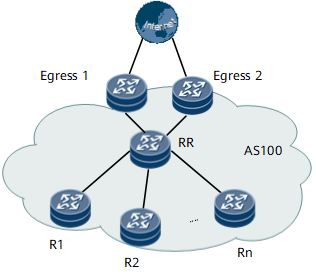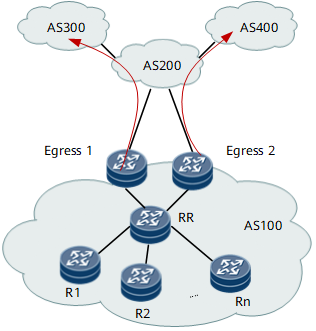BGP Route Load Balancing in an RR Scenario
Networking Requirements
On the network shown in Figure 1, an RR is deployed in AS 100. The RR learns external routes from two egress routers and reflects the routing information to its clients (R1, R2, ..., Rn). All the clients have equal-cost upstream links to the egress routers. However, the RR selects an optimal route from those received from the two egress routers and reflects only the optimal route to its clients. Therefore, the external routing information received by each client has only one next hop (either egress 1 or 2). As a result, traffic cannot be load-balanced.
Solution One
Create loopback 1 on both egress 1 and egress 2, configure the same IP address for the two interfaces, and establish IBGP peer relationships between the two interfaces and the RR.
After BGP routes recurse to IGP routes, traffic can be load-balanced between routes from each client to each egress router because of the same next hop addresses on the two egress routers.

Use the loopback1 on egress 1 and egress 2 only to establish IBGP peer relationships to prevent unpredicted risks.
Solution Two
Configure a route-policy on the RR in AS 100 so that traffic destined for AS 300 passes through egress 1 and that traffic destined for AS 400 passes through egress 2, as shown in Figure 2.
Perform the following operations on the RR in AS 100:
- Run the system-view command to enter the system view.
- Configure AS_Path filters in regular expression to differentiate routes destined for AS 300 and AS 400.
- Run the ip as-path-filter ToAS300 permit [ 300 ] command to configure an AS_Path filter for routes destined for AS 300.
- Run the ip as-path-filter ToAS400 permit [ 400 ] command to configure an AS_Path filter for routes destined for AS 400.
- Configure node 10 for the route-policy to set the next hop of routes destined for AS 300 to egress 1.
- Run the route-policy policy1 permit node 10 command to create node 10 for the route-policy.
- Run the if-match as-path-filter ToAS300 command to configure an if-match clause to match routes destined for AS 300.
- Run the apply ip-address next-hop ipv4-address command to set the next hop of routes destined for AS 300 to egress 1.
- Configure node 20 for the route-policy to set the next hop of routes destined for AS 400 to egress 2.
- Run the route-policy policy1 permit node 20 command to create node 20 for the route-policy.
- Run the if-match as-path-filterToAS400 command to configure an if-match clause to match routes destined for AS 400.
- Run the apply ip-address next-hop ipv4-address command to set the next hop of routes destined for AS 400 to egress 2.
- Reflect the BGP routes after the next hop modification to clients.
- Run the system-view command to enter the system view.
- Run the bgp 100 command to enter the BGP view.
- Run the ipv4-family unicast command to enter the BGP IPv4 unicast address family view.
- Run the peer route-policy group-name policy1 export command to configure an AS_Path-based route-policy.
- Run the commit.

In this instance, an AS_Path-based filter is configured on the RR to filter routes. To implement more refined route filtering, you can configure a community filter or an ACL, IP prefix list, extcommunity filter, or RD filter, among which, the extcommunity filter and RD filter take effect only on VPNv4 and VPNv6 routes, and the rest filters take effect on both VPN routes and public routes.
Follow-up Procedure
Run the save command to save the current configuration to the configuration file when a set of configuration is finished and the expected functions have been achieved.

